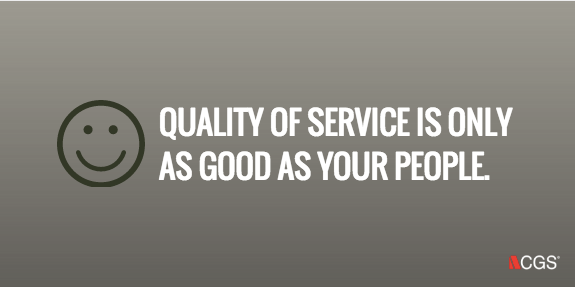Topics
At-home vs. Contact Center Agents: What to Consider When Choosing a BPO Model

As a result of increased demand for customer service and advancements in communications technology, business process outsourcing (BPO) is experiencing significant growth for both contact centers and work-from-home models. The trend for working from home, across various industries and job functions, may prove durable: One-in-five Americans currently works from home at least one day a week, and this number is only expected to increase.[i] Organizations that turn to the work-from-home model are often seeking benefits such as reduced costs, the flexibility of contracted employees (as opposed to full-time staff), and fast access to a large pool of potential customer representatives.
The work-from-home model often can be a convenient, low-cost option for companies in need of a customer service solution. At the same time, however, there may be drawbacks to this configuration, some of which can get overlooked in the search for cost savings. Before making a decision to outsource call center services to a work-from-home provider, it’s important to understand the strengths and weaknesses of the model (and the particular company). Then, evaluate them against your goals and requirements for a customer service program, in order to make the most-effective choice for your business and your customers.

Recruiting, Employee Skills and Training
Companies that manage customer service requests need to have enough agents to handle customer contacts, and those agents need to have the skills, knowledge and training to handle them in a satisfactory manner. Call volume and the complexity of the situations that the customer contact agents will be dealing with are the primary factors affecting recruiting needs. In terms of recruiting, work-at-home providers may have an advantage over others, at least in terms of their ability to recruit a high number of people, quickly. As they are not limited to searching within a certain geographical area, these companies can reach a large number of potential candidates in a short amount of time.
In terms of recruiting, the process of becoming a work-from-home call center agent often occurs mostly or entirely online. It usually requires a standard application, and a skills assessment, as well as a check to ensure the candidate has adequate equipment for working from home. This type of recruiting may be more suited to finding “jack-of-all trades” agents than candidates with high-tech skills or those with experience in industries that have specific compliance requirements, for example.
As with any organization, the level of service you can provide can only be as good as the people who represent your organization. In addition to hiring qualified and skilled employees, a provider should offer employee training, to educate new hires on brand and industry standards, and to help existing employees grow their knowledge and skill sets.
And, today’s consumers expect more in terms of customer experience, often across multiple platforms and channels. To keep up with the competition, call center agents need training on how to handle situations across all channels in a way that will create a positive impression and ultimately satisfaction in the minds of your customers. This means training employees on brand and product knowledge, and also potentially on tools and technology, including social media, for use when communicating with customers.
While both in-person and web-based training has the potential to be effective, evidence suggests that there may be more potential for ongoing, valuable training and knowledge assessment in an environment that can include a component of in-person instruction. On-site facilities have team leaders and managers tracking performance. If any issues are reported or remediation is needed, there are training facilities and staff for a formal process. At-home models tend to offer strictly web-based training, which may not be as effective or engaging for all learners.

Visibility, Processes and Security
Despite technological advances, differences remain between teams that work together in the same building and those that collaborate remotely. At an in-house BPO or call center provider, managers can see what their teams are doing throughout the day – assist with issues in-person, ensure employees are on-task, see the mood of the team and individual agents. Alternatively, these tasks can be handled for remote workers with communications and task-tracking software, but the visibility for in-person teams may help them to be managed more smoothly.
Another key concern for businesses that are using outsourcing providers is ensuring security. From integrated security software to firewalls to remote monitoring and management, there are a range of possible measures to minimize threats. Work-at-home will often rely on a secure VPN to have agents connect. While VPNs provide a high level of security, there are some measures that can only be enacted when agents share a physical space. If agents will be dealing with particularly sensitive information, such as credit cards, social security numbers or bank account information, for example, you may need to prohibit them from using personal devices, which isn’t viable in a work-at-home environment.
Shared Queues and Specialization
With many work-from-home models, agents are a part of a shared queue, meaning one employee can be supporting a wide variety of brands and services. This can be very cost-effective, especially for businesses that have relatively low-volume support needs. However, it often can mean that agents aren’t specialized in any one particular industry. Choosing an outsourcing provider that utilizes a dedicated agent model and specializes in a specific industry can increase the odds that agents will have a solid background understanding of the type of issues they’ll be handling. This kind of specialization becomes more important as the complexity of tasks agents may be dealing with increases.
Other considerations
A recent Gartner report suggested that for many companies, cost reduction should not rank as the highest priority when it comes to outsourcing. That in fact, contracting with the lowest-cost provider possible could end up costing more in customer dissatisfaction and attrition that, with security and other risks, it may not end up delivering as strong an ROI as another provider.
When speaking with an outsourcing provider, make sure to conduct a thorough check into the organization’s reputation and the staff’s skill set. Ask for client references, industry-specific case studies and examples of successful services the organization has provided in the past. All of this information is critical in determining which BPO service model will be the right fit for your business.
References:
https://www.cgsinc.com/blog/providing-quality-customer-care-while-cutting-costs
https://www.cgsinc.com/blog/best-bpo-resources-analysts-guide-your-outsourcing-decision
https://www.cgsinc.com/blog/top-7-reasons-companies-outsourcing-2016
[i] http://www.forbes.com/sites/kenrapoza/2013/02/18/one-in-five-americans-work-from-home-numbers-seen-rising-over-60/

